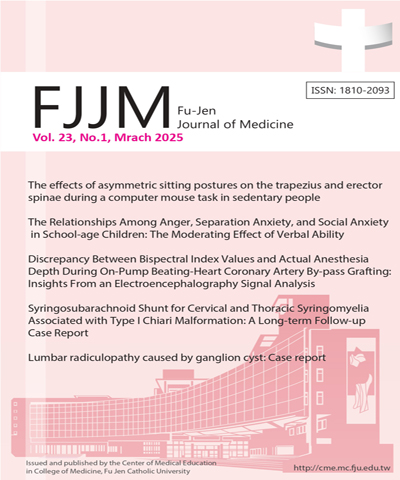
輔仁醫學期刊/Fu-Jen Journal of Medicine
輔仁大學醫學院,正常發行
選擇卷期
- 期刊
Background and Purpose: Meniere's disease (MD) and vestibular migraine (VM) have overlapping clinical symptoms. We conducted a single-center observational study to examine the potential role of inner ear test batteries, namely the cervical vestibular-evoked myogenic potential (c-VEMP) and the caloric test, in the differentiation between patients with MD and VM. Methods: A retrospective chart review of patients presenting with dizziness or vertigo symptoms was performed from Feb 2018 to Feb 2019 in the outpatient clinic. All patients underwent complete history taking, physical examination, and an inner ear test battery. Eleven MD (9 females, aged 58.1 ± 11.7 years) and 19 VM patients (18 females, aged 42.3 ± 14.7 years) were enrolled for analysis. We examined the differences in clinical characteristics, presenting symptoms, and the presence of abnormal test results in audiometry, c-VEMP, and the caloric test between the two groups using a Fisher’s exact test. Results: Patients with VM were significantly younger than patients with MD (P = 0.001). Patients with MD had a significantly higher incidence of unilateral sensorineural hearing loss than patients with VM (P = 0.012). Caloric test results showed significantly higher abnormal response rates in the MD than in the VM group (72.7% vs. 26.3%, respectively, adjusted P = 0.030). In contrast, the c-VEMP test demonstrated no significant differences between the MD and VM groups in interaural difference abnormalities (0% vs. 10.5%, adjusted P = 0.544) and p13 delay or absent responses (36.4% vs. 10.5%, adjusted P = 0.298). Conclusion: The high rates of abnormal responses in caloric tests may facilitate distinguishing MD from VM.
- 期刊
Background and purpose: The long-term effect of gout on the risk of acute myocardial infarction (AMI) in young adults is unknown. This nationwide cohort study aimed to investigate the independent association between gout and the incidence of AMI, especially in patients younger than 40 years. Methods: We retrospectively obtained data of 60,997 patients (683,652 person-years) diagnosed with gout in 2002 from the Longitudinal Health Insurance Database, Taiwan. All participants were followed up from the date of enrollment until AMI or the end of data collection in 2013, whichever occurred first. Multivariate Cox proportional hazards models and Nelson-Aalen cumulative hazard function were used to evaluate the risk of AMI in patients with gout. Results: The incidence of AMI was 3.80 and 1.01 per 1000 person-years in patients with and individuals without gout, respectively. After adjustment for demographics and comorbidities, individuals with gout had a higher overall risk of AMI (hazard ratio, HR=1.21, 95% confidence interval, CI=1.15-1.26), and this finding was noted in men (HR=1.25, 95% CI=1.19-1.31) and women (HR=1.19, 95% CI=1.09-1.30). Gout in adults aged 20-39 years had a higher independent effect on AMI in men (HR=1.92, 95% CI=1.54-2.39) than in women (HR=1.34, 95% CI=0.48-3.70). Conclusion: Our study reveals that gout is a risk factor for AMI, particularly in adults younger than 40 years. Given the potential long-term complications of AMI among young patients, as well as their families and society, the results of this study may contribute to the development of early pharmacological interventions to prevent AMI.
- 期刊
Twiddler's syndrome is a rare cause of defibrillator lead displacement, resulting in defibrillator malfunction. The purpose of this report is to present the case of a 57-year-old man with history of dilated cardiomyopathy and ventricular tachycardia with dislodged defibrillator leads due to lead twisting and coiling in the defibrillator pocket at 18 months post-implantation. The patient presented to the hospital with frequent hiccups due to phrenic nerve stimulation by the dislodged atrial lead. Our methods of treatment were removing the defibrillator generator and the twisted leads, and then implanting a new defibrillator generator and a new lead with reinforced stiches from the other side of the chest. The patient recovered uneventfully. During follow-up, no migration of the lead and pulse generator occurred for up to 5 years. In conclusion, frequent hiccups may be a presentation of Twiddler's syndrome in patient with implantable cardioverter-defibrillator. The patient was successfully managed with re-implantation on the other side of chest.
- 期刊
The extension of human life spans resulting from advances in medicine and health means that the aim of health care is no longer just to keep people alive, but also to provide a good quality of life. Opinions vary on how to improve quality of life today. This article presents the concept of "TIMES of Health Care", using the five letters in "TIMES" to describe the five principles of health care: helping patients to set targets (T) for their new lives; building healthy interpersonal relationships (I) among patients; making good use of music or music therapy activities (M); focusing on a patient's past life experience (E), and ensuring the safety (S) of patients' lives. These five principles are not independent, but instead have a multiplicative effect on each other. This article explores the concept of "TIMES" as principles for future health care.

